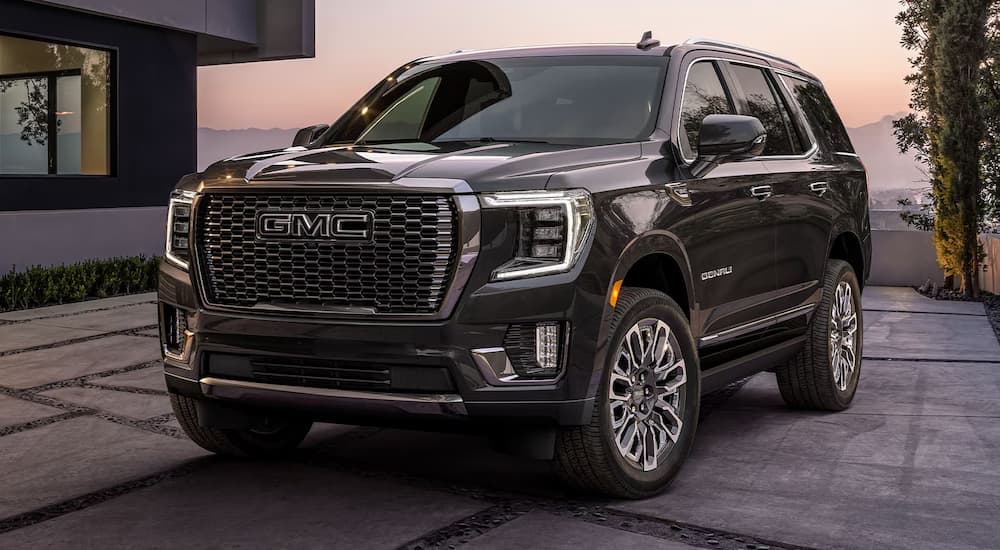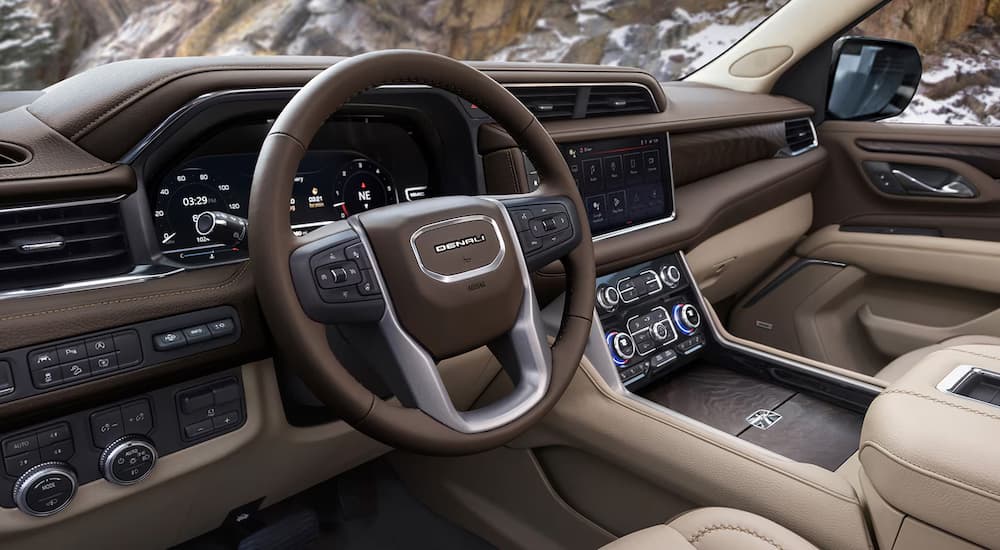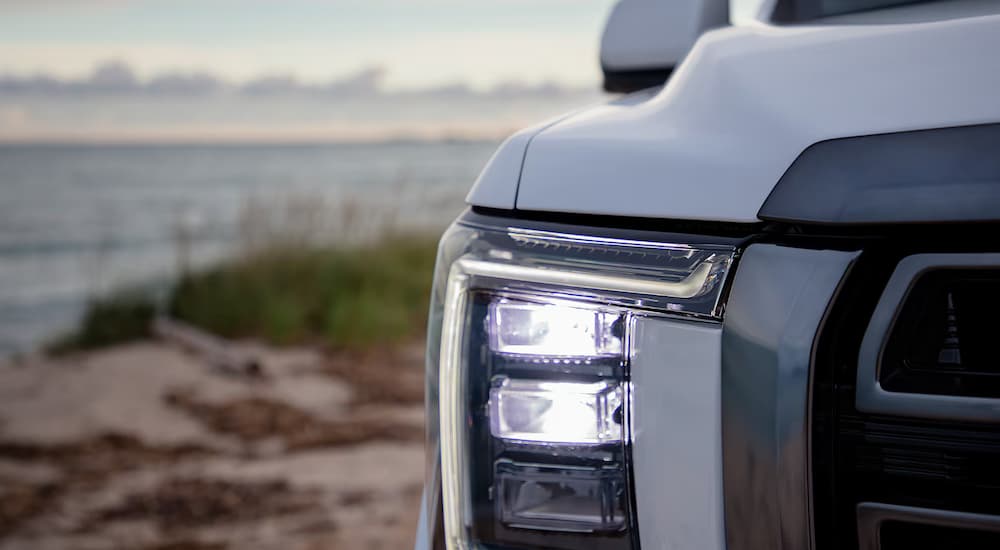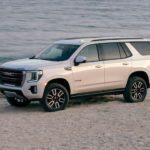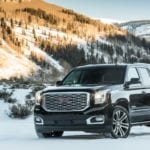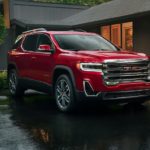You know what you’re getting at your local GMC dealer: trucks. No other division of General Motors has such a single-minded focus on one particular category of vehicles. But GMC takes things a step beyond just offering pickups and SUVs, positioning itself as a seller of premium-grade trucks that can sometimes blur the lines between utilitarian vehicles and luxury automobiles—and that’s how they intended it. Their advertising tagline says “professional grade,” but if you’re a rancher or factory owner who doesn’t want to sacrifice luxury for capability, GMC is your brand. And no other GMC truck exemplifies this design philosophy more than the GMC Yukon.
The 2024 GMC Yukon is the culmination of over thirty years of rugged capability combined with rugged design. The Yukon anchors the high end of GMC’s SUV lineup as its full-sized offering. And we do mean full-sized: the long-wheelbase version, the Yukon XL, measures 225.2 inches in total length, making it one of the largest passenger trucks you can get your hands on. It offers three rows of seats that comfortably fit adults, along with a positively cavernous cargo area. And all this comes wrapped in a luxury-oriented approach that yesteryear’s truck owners could only dream of.
Let’s take a look back to the origins of the Yukon, back when passenger trucks were first beginning to be referred to as SUVs. We’ll see what the Yukon’s role was at its introduction and how its design has evolved along with the changing role of SUVs in American society.
The Early ’90s
Folks of a certain age may have fond memories of the GMC K5 Jimmy, the Yukon’s predecessor. This full-sized passenger truck was designed with a go-anywhere philosophy, but its ride, handling, noise levels, and creature comforts would fall way short of what SUV drivers are used to today. Plus, it was last redesigned in 1973, so by the early 1990s, it was time for the K5 Jimmy to be retired. The Yukon succeeded it for the 1992 model year.
The 1992 GMC Yukon marked a significant leap forward in refinement and driving dynamics compared to its predecessor. Designed as the ultimate expression in large SUVs, the Yukon embodied a luxury-oriented design philosophy that set it apart in its class. Initially available as a two-door SUV in SL and SLE trims, the Yukon featured a new design language of rounded edges and aerodynamic details, such as door handles that were flush with the truck’s sheet metal. While it was still an old-fashioned body-on-frame SUV (which it still is today), the overall look was much more modern than the blocky appearance of the K5 Jimmy.
The modern aesthetic wasn’t just skin-deep. Under the hood, the 1992 Yukon housed a 5.7L V8 engine delivering 210 hp and 300 lb-ft. of torque, which were very decent numbers for the era. This powerplant provided ample grunt for both on-road cruising and off-road adventures. Engineered to incorporate the latest technology and refinement from GMC, the 1992 Yukon offered a blend of performance, comfort, and style that appealed to drivers seeking a premium SUV experience during that era.
Later that decade, the Yukon premiered a special edition whose name has become synonymous with premium-grade luxury among SUV drivers: the Yukon Denali. This version of the Yukon offered a special appearance package with unique sheet metal, a custom grille, and upgraded lights. Again, the changes went beyond the exterior as the Denali wrapped the driver and passenger in luxury details that were rare for the time, including premium heated seats.
A New Millennium
Having established itself as a premium, thoroughly modern SUV, the original Yukon would be a tough act to follow. A redesigned Yukon debuted for the 2000 model year, offering an evolution of the rounded and modern design language that had debuted eight years earlier. With its sleek lines, plentiful chrome trim, and aerodynamic design, the 2000 Yukon made a statement on the road. Despite having a lighter body than the 1999 Yukon, the 2000 model provided increased structural rigidity, more interior room, and greater capability than ever before.
The Yukon XL was now available as a 1500 or heavier-duty 2500 series model. The standard engine on all Yukon and Yukon XL 1500 models was the 4.8-liter Vortec V8, delivering 275 hp and 290 foot-pounds of torque. Optional on the Yukon and standard on the Yukon XL 1500 was a 5.3-liter V8 engine, which generated 285 hp and 325 lb-ft of torque. The Yukon XL 2500 has a 300-horsepower 6.0-liter gasoline engine. Diesel options would have to wait for the next generation.
The overall driving experience was better. Motor Trend noted at the time, “This vehicle feels tight, corners better, and…rides more like a luxury car than a rough-and-tumble truck.” They also took note of its comfortable and well-appointed interior.
The third-generation Yukon debuted in 2007, featuring a return to a more square and angular design idiom, an evolution that has continued to this day. With redesigned chrome brightwork and jeweled headlamps and tail lights, we start to see a modern luxury design aesthetic taking hold. Likewise, the interior began to feature modern amenities like touch-screen navigation.
This evolution, both inside and out, carried into the fourth-generation Yukon in the 2015 model year. By now, GMC had evolved into a signature style with a large chrome grille and C-shaped LED lighting. The sheet metal expressed a more muscular design language with building front fenders and character lines running the length of the hood and the sides.
Modernity was the theme under the skin, with features like a premium Bose sound system, ambient interior lighting, dual-firmness foam seating, and much more. Modern safety features like Forward Collision Alert protected the Yukon’s occupants. Magnetic Ride Control provided an even more luxurious ride. By this point, GMC had truly evolved its design language and premium-grade selling point.
The Current Generation
This brings us to the current generation, first introduced for the 2021 model year. Exterior styling became bigger and bolder than ever, with a very distinctive evolution of its C-shaped lighting elements and sophisticated chrome trim. Power is greater than ever, with a 6.2-liter V8 cranking out 420 hp and 460 -lb-ft of torque, combined with a Dynamic Fuel Management System that delivers far better fuel efficiency than one would expect from so much power.
This generation also saw the first Yukon AT4 model, the ultimate expression of the Yukon’s go-anywhere capability. This off-road-oriented edition features special exterior trim, a greater approach angle, recovery hooks, and other features you would expect on a serious trail-busting SUV. The AT4’s interior features standard leather seating with contrasting stitching. All editions of the current generation of Yukon offer multiple camera views to make parking and trailering easier. A head-up display lets drivers keep their eyes on the road, while the Air Ride Adaptive Suspension makes the ride more comfortable than ever.
A Design Philosophy Forged in Steel
Each generation of the Yukon has pushed the boundaries of what is expected from a professional-grade SUV, evolving not just in terms of power and performance but in luxury and design as well. The introduction of the Denali and AT4 models further cements the Yukon’s status as a vehicle that does not compromise on luxury for capability or vice versa. With advancements in technology, design, and performance, the GMC Yukon embodies the perfect blend of durability and premium elegance.
